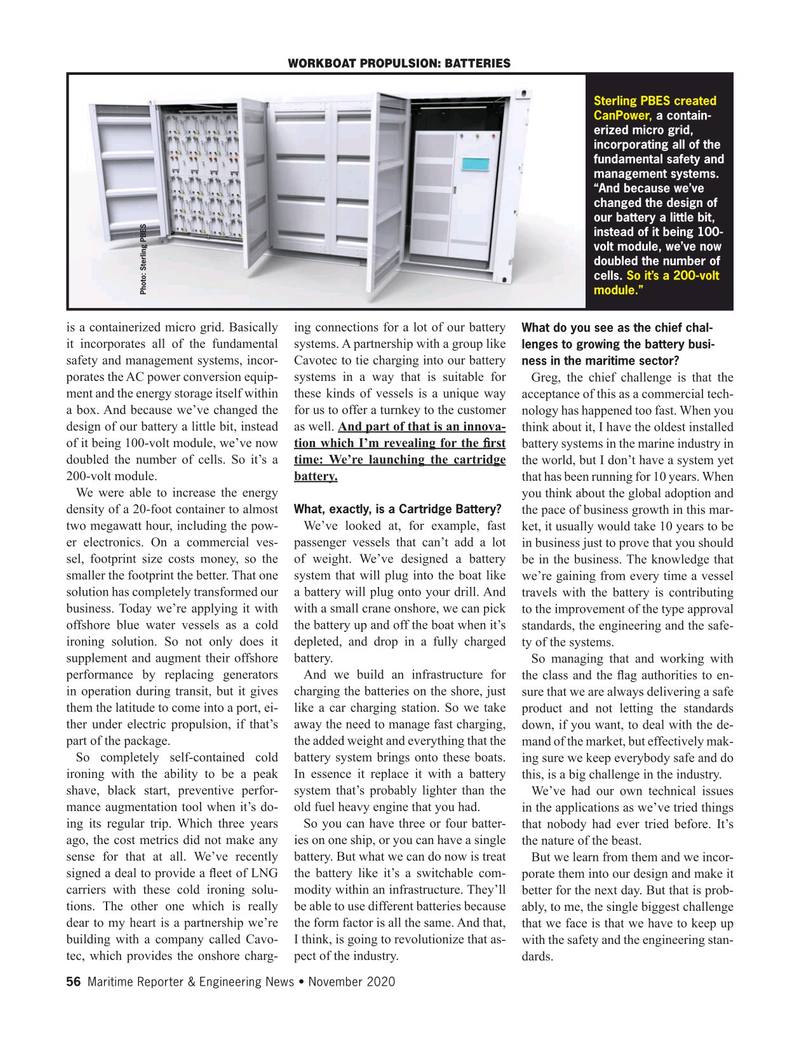
Page 56: of Maritime Reporter Magazine (November 2020)
Workboat Edition
Read this page in Pdf, Flash or Html5 edition of November 2020 Maritime Reporter Magazine
WORKBOAT PROPULSION: BATTERIES
Sterling PBES created
CanPower, a contain- erized micro grid, incorporating all of the fundamental safety and management systems. “And because we’ve changed the design of our battery a little bit, instead of it being 100- volt module, we’ve now doubled the number of cells. So it’s a 200-volt module.”
Photo: Sterling PBES is a containerized micro grid. Basically ing connections for a lot of our battery
What do you see as the chief chal- it incorporates all of the fundamental systems. A partnership with a group like lenges to growing the battery busi- safety and management systems, incor- Cavotec to tie charging into our battery ness in the maritime sector?
porates the AC power conversion equip- systems in a way that is suitable for Greg, the chief challenge is that the ment and the energy storage itself within these kinds of vessels is a unique way acceptance of this as a commercial tech- a box. And because we’ve changed the for us to offer a turnkey to the customer nology has happened too fast. When you design of our battery a little bit, instead as well. And part of that is an innova- think about it, I have the oldest installed of it being 100-volt module, we’ve now tion which I’m revealing for the ? rst battery systems in the marine industry in doubled the number of cells. So it’s a time: We’re launching the cartridge the world, but I don’t have a system yet 200-volt module. battery. that has been running for 10 years. When
We were able to increase the energy you think about the global adoption and density of a 20-foot container to almost the pace of business growth in this mar-
What, exactly, is a Cartridge Battery?
two megawatt hour, including the pow- We’ve looked at, for example, fast ket, it usually would take 10 years to be er electronics. On a commercial ves- passenger vessels that can’t add a lot in business just to prove that you should sel, footprint size costs money, so the of weight. We’ve designed a battery be in the business. The knowledge that smaller the footprint the better. That one system that will plug into the boat like we’re gaining from every time a vessel solution has completely transformed our a battery will plug onto your drill. And travels with the battery is contributing business. Today we’re applying it with with a small crane onshore, we can pick to the improvement of the type approval offshore blue water vessels as a cold the battery up and off the boat when it’s standards, the engineering and the safe- ironing solution. So not only does it depleted, and drop in a fully charged ty of the systems.
supplement and augment their offshore battery. So managing that and working with performance by replacing generators And we build an infrastructure for the class and the ? ag authorities to en- in operation during transit, but it gives charging the batteries on the shore, just sure that we are always delivering a safe them the latitude to come into a port, ei- like a car charging station. So we take product and not letting the standards ther under electric propulsion, if that’s away the need to manage fast charging, down, if you want, to deal with the de- part of the package. the added weight and everything that the mand of the market, but effectively mak-
So completely self-contained cold battery system brings onto these boats. ing sure we keep everybody safe and do ironing with the ability to be a peak In essence it replace it with a battery this, is a big challenge in the industry. shave, black start, preventive perfor- system that’s probably lighter than the We’ve had our own technical issues mance augmentation tool when it’s do- old fuel heavy engine that you had. in the applications as we’ve tried things ing its regular trip. Which three years So you can have three or four batter- that nobody had ever tried before. It’s ago, the cost metrics did not make any ies on one ship, or you can have a single the nature of the beast. sense for that at all. We’ve recently battery. But what we can do now is treat But we learn from them and we incor- signed a deal to provide a ? eet of LNG the battery like it’s a switchable com- porate them into our design and make it carriers with these cold ironing solu- modity within an infrastructure. They’ll better for the next day. But that is prob- tions. The other one which is really be able to use different batteries because ably, to me, the single biggest challenge dear to my heart is a partnership we’re the form factor is all the same. And that, that we face is that we have to keep up building with a company called Cavo- I think, is going to revolutionize that as- with the safety and the engineering stan- tec, which provides the onshore charg- pect of the industry. dards.
56 Maritime Reporter & Engineering News • November 2020
MR #11 (50-65).indd 56 11/9/2020 11:40:36 AM

 55
55

 57
57
